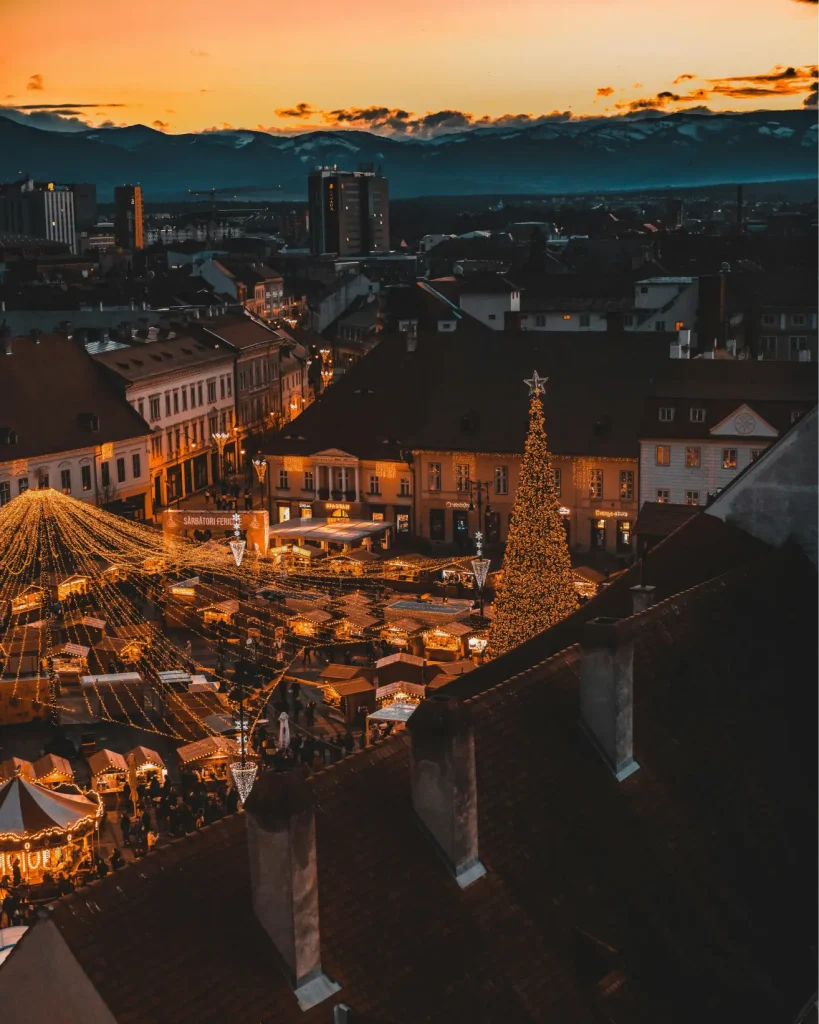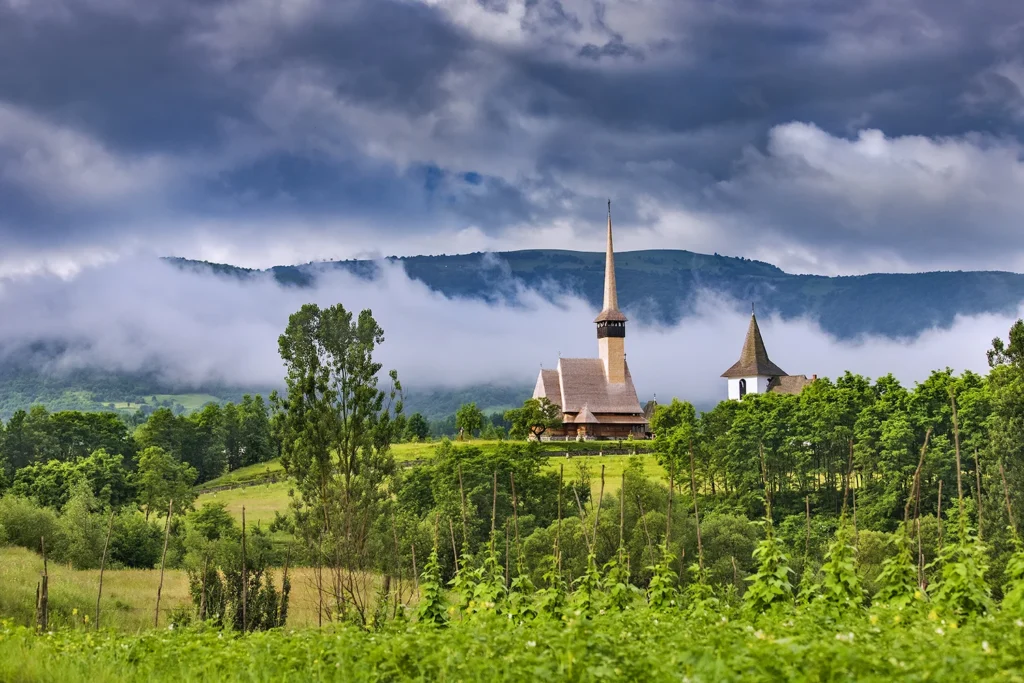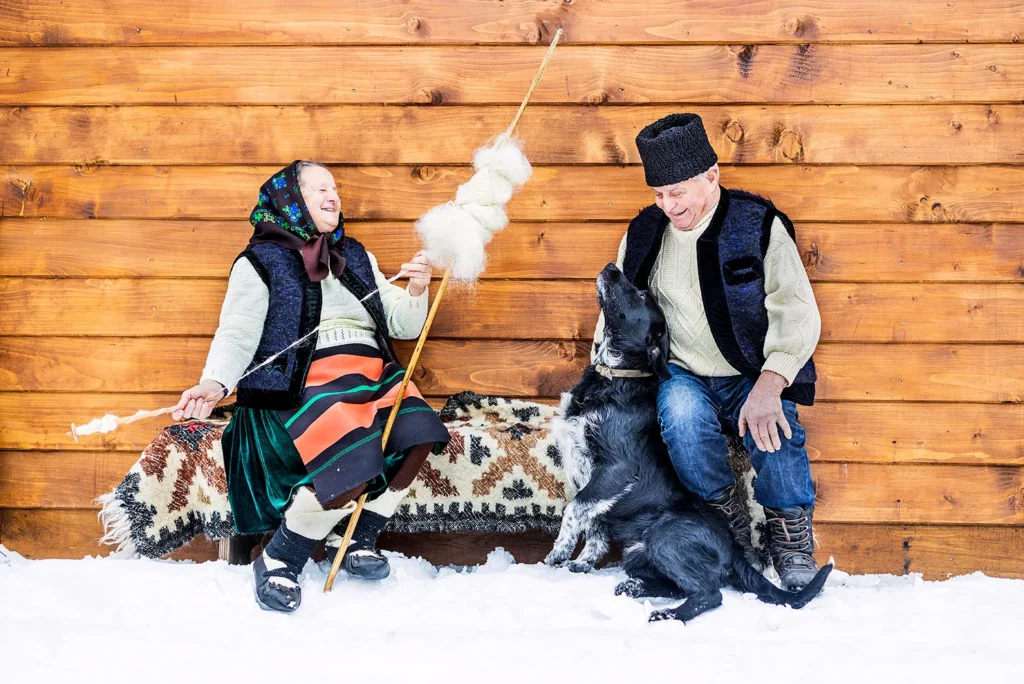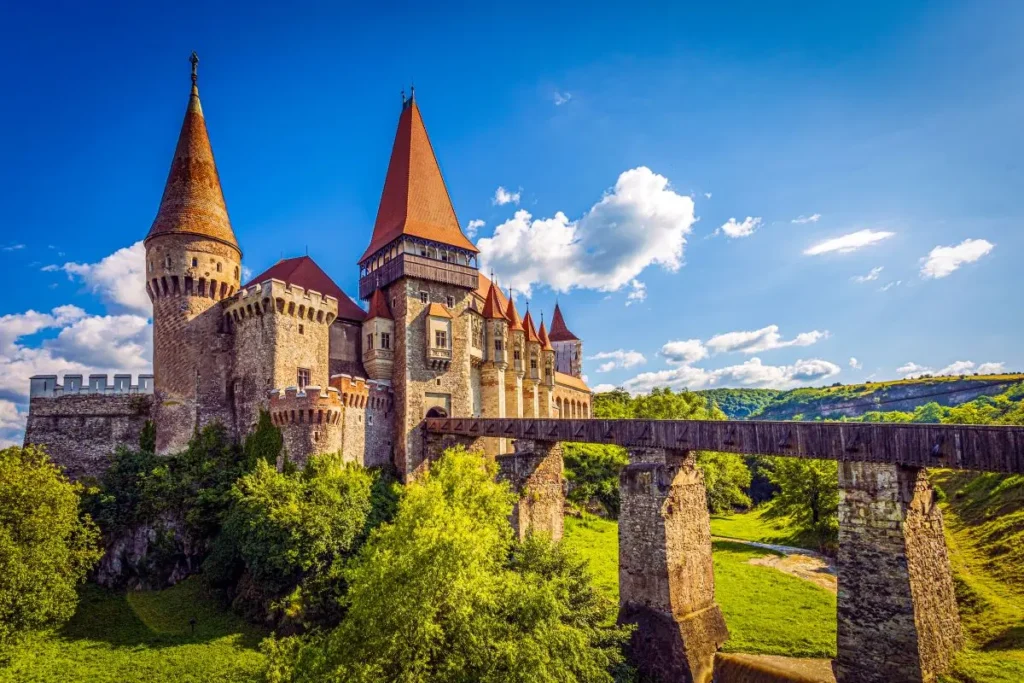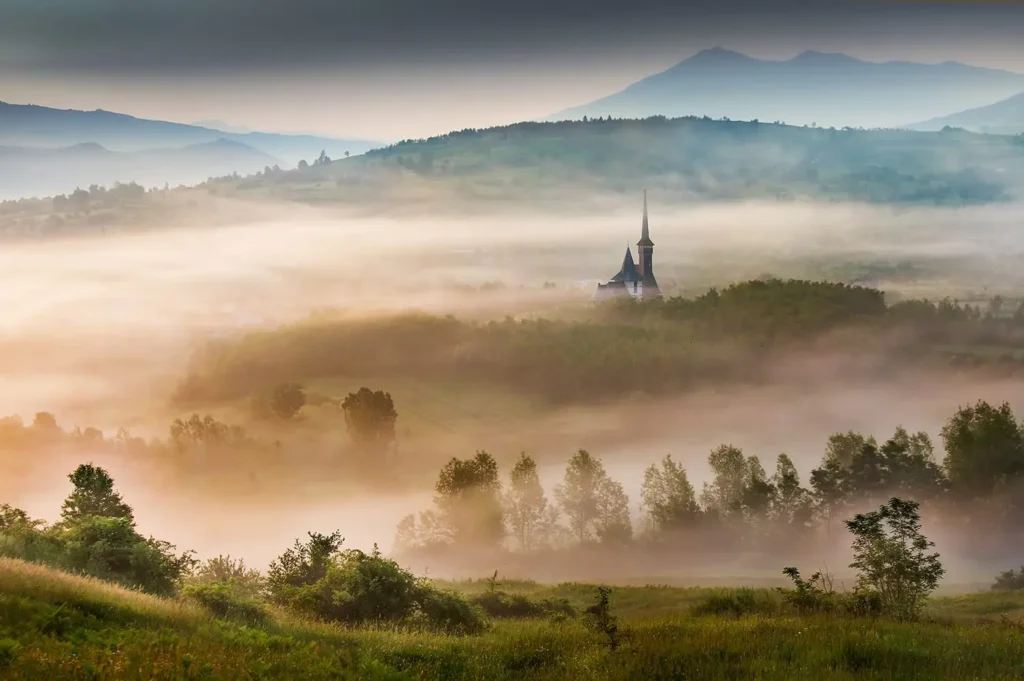Chapters
Romanian Culture & Traditions
There’s a certain magic that fills the air as Christmas approaches in Romania. As one of the country’s most cherished religious holidays alongside Easter, Christmas represents a time for family gatherings, love, respect, and gift-giving – a truly vibrant spectacle, particularly appealing to children eager to meet Moș Crăciun (Santa Claus) and receive their gifts.
Celebrating Christmas in Romania
In Romania, like many countries around the world, Christmas is celebrated on December 24th and 25th. However, the festive traditions here are unique and extend well beyond the simple exchange of gifts and decorating the Christmas tree.
The Nativity Fast of 40 days commences on November 14th. This period is dedicated to purification – of the body, soul, and home – in preparation for the proper celebration of Jesus’s birth. People observe fasting, confession, and the Holy Communion.
Unlike the Catholic fast, the Orthodox one also forbids the consumption of dairy and egg products, but the consumption of fish is permitted on certain days. Even though the fast lasts for more than a month, many people respect this religious practice, at least for a couple of days.
Although it is not a Christmas tradition, Romanians also celebrate St. Nicholas. St. Nicholas is celebrated separately on December 5th when children clean their boots and leave them by the door, hoping for presents. St. Nicholas is usually called Moș Nicolae (Old Man Nicholas), and the legend says that if it snows on his day (December 6th), he has shaken his beard, and winter will officially begin.

https://medstudentadvisors.com/st-nicholas-sfantul-nicolae-mos-nicolae-5th-december.html
Harmony Between Pagan and Christian Customs
A fascinating aspect of Romanian Christmas traditions is the blend of ancient pagan customs and Christian traditions. These distinct elements coalesce to create truly captivating rituals. A good example is “Ignat” on December 20th, when countryside dwellers traditionally sacrifice one or more pigs, preparing the meat for various traditional delicacies. Though originating from a pagan custom, Ignat has gradually merged into Romania’s Christmas practices.
Singing The Old World Carols
Undoubtedly, the most cherished Romanian Christmas tradition is caroling. Tracing their origins back to 4th century Rome,
Romanian Christmas carols are some of the world’s oldest. These carols, with tunes and themes varying by region, share stories of the birth of Jesus Christ, convey blessings to those who open their doors to the carol singers, and express wishes of good luck, health, and love for the New Year. In Romanian culture, Christmas is a celebration for all of God’s creations, so many carols focus on blessing Mother Nature as well.
Despite the variety, the most beloved carols are, without a doubt, the ones glorifying the birth of Jesus. The biblical scene is described in detail, and the emotional lyrics focus on the hard conditions Virgin Mary had to endure to give birth to baby Jesus. The long and tiring journey from Nazareth to Bethlehem, the cold winter night, the stable, the messenger star, and the arrival of the Magi are all wonderfully sang in rhymed lyrics. The carols plead for harmony and peace among people, and children are usually the ones who sing them because they are considered the purest and closest to God.
In some regions of Romania, children go carolling early in the day, and teenagers and young adults go after sunset. It is truly breathtaking to see groups of little kids, happy and cheerful, eager to demonstrate their talent despite the freezing temperatures and heavy snows. In the countryside, they are usually dressed in traditional Romanian clothes, and they are incredibly cute, especially when they try to take a very proud and solemn face. They take Christmas carolling very seriously, and they usually start practising the carols weeks in advance just to be sure that their performance will be perfect.

kids singing in romania carols
Feasting on Traditional Delicacies
As the dawn breaks at 5 am on Christmas Day, the preparation of the traditional cozonac, a sweet sponge cake with nuts and cocoa filling, begins. The day then progresses to the preparation of traditional pork specialities like smoked ham, sausages, jellied pork, and greaves. A traditional Romanian Christmas is incomplete without sarmale (cabbage rolls), paired with sour cream, hot polenta, and hot peppers, and a glass of palinka to wash it all down.
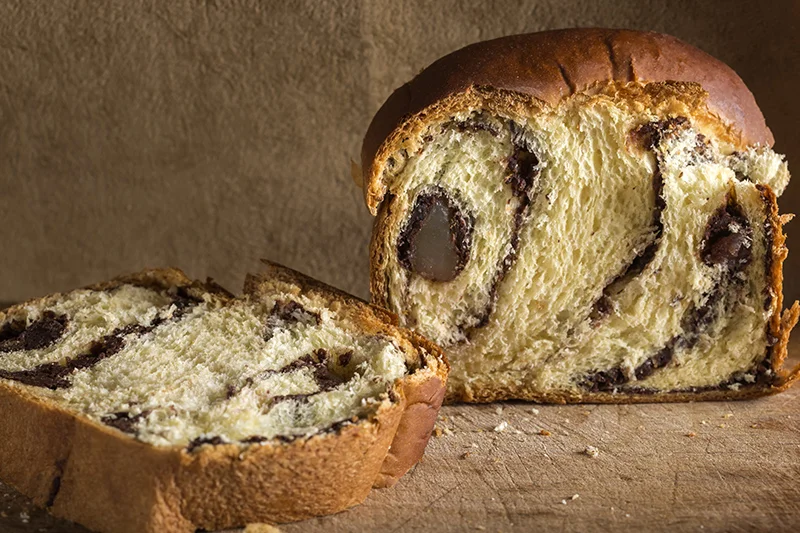
Experiencing the Christmas Markets
Romania is filled with beautiful Christmas markets, but few of them are surrounded by historical buildings and beautiful architecture and filled with Romanian Christmas ornaments.
The Sibiu Christmas Market, set amidst historical buildings and stunning architecture, is considered one of the most beautiful in the country. The market boasts everything from roasted almonds and mulled wine to traditional Romanian ornaments and handcrafted items. The Bucharest Christmas Market, too, lasting the entire month of December, is filled with over 100 wooden huts offering delicious street food, mulled wine, and unique gifts.

The Joy of Celebrating
On the first day of Christmas, the morning starts with a visit to the church, followed by children opening their gifts from Santa. The following three days are reserved for relaxation, visiting family members, and savoring the delightful festive food. Imagine yourself nestled in a warm corner, overlooking the snowy Carpathian landscape, a glass of red wine in hand, truly immersing yourself in an authentic Romanian Christmas.
So, if you’re planning to celebrate Christmas in a unique and memorable way, Romania, with its rich traditions and hearty festivities, is a destination worth considering. And before you go, learn how to say Merry Christmas in Romanian: Crăciun Fericit!
Romanian popular holiday
Romania is a country with a rich and vibrant culture, and this is reflected in the numerous holidays and festivals that are celebrated throughout the year. Here are some of the most significant holidays and festivals in Romania:
- New Year’s Day (Anul Nou) – January 1: Like much of the world, Romanians celebrate the New Year with fireworks, parties, and family gatherings.
- Unification Day (Ziua Unirii) – January 24: This holiday commemorates the unification of Moldavia and Wallachia in 1859, which marked the birth of the modern Romanian state.
- Martisor Day – March 1: This marks the beginning of spring. Men offer women small trinkets or charms called “Martisor” as a symbol of respect and love.
- Easter (Paști) – Varies: As a predominantly Orthodox Christian country, Romania celebrates Easter with great pomp. It’s a time for church-going, egg painting, and family gatherings. Easter Monday is also a public holiday.
- Labor Day (Ziua Muncii) – May 1: Labor Day is celebrated with picnics and outdoor concerts. Traditional food like “mici”, a kind of grilled meatball, is often enjoyed.
- Children’s Day (Ziua Copilului) – June 1: This holiday is dedicated to children. Various events and activities are organized, and children often receive gifts from their parents
- St. Mary’s Day (Adormirea Maicii Domnului) – August 15: One of the most important religious holidays, it’s considered the “Easter of the summer” and often involves church services and pilgrimages.
- National Day (Ziua Națională) – December 1: This is Romania’s National Day, celebrating the union of Transylvania with Romania in 1918. It’s marked with military parades, traditional dances, and music.
- Christmas (Crăciun) – December 25-26: Christmas is celebrated with a variety of traditions, such as carolling and special meals. Children often get presents from Moș Crăciun (Santa Claus).
In addition to these national holidays, Romania also celebrates many regional and local festivals which showcase the country’s rich folk traditions, arts, and culinary delights. It’s definitely worth timing your visit to coincide with these lively events.
Romania Public Holidays & Celebrations
Romanians observe several public holidays throughout the year, many of which are rooted in Orthodox Christian beliefs and customs. Apart from Easter and Christmas, other key religious holidays include Saint Andrew’s Day, the Day of Saint John the Baptist, and Orthodox Good Friday. Saint Andrew, known as Sfantul Andrei in Romanian, is the country’s patron saint and is celebrated on November 30th. According to local folklore, Saint Andrew was the one who Christianized the Dacians, the ancient inhabitants of the Romanian principalities.
The Assumption of Mary, or Adormirea Maicii Domnului, is another significant religious holiday in Romania, celebrated on August 15th. It is believed to be the day when Saint Mary, the mother of Jesus Christ, was taken to heaven. Also known as Saint Mary’s Day or St. Mary’s Day, this date marks one of the most important religious celebrations in the country, with many Romanians attending the church services and participating in processions.
Another official holiday, the Day of Saint John the Baptist, is observed on January 7th and involves customs such as the ritual of washing for good health.
Romania also commemorates several important events in its history. The Union Day, also known as Unification Day or Great Union Day, is celebrated on December 1st and marks the unification of Transylvania, Bessarabia, and Bukovina with the Romanian Kingdom in 1918. Constitution Day on May 29th, acknowledges the day when the Constitution of Romania was ratified in 1866.
Not all public holidays are religious or national. Romania also celebrates Labour Day on May 1st, and International Women’s Day on March 8th, reflecting its commitment to honouring the role of workers and women in society.
Other Public Holidays in Romania
There are several other notable public holidays in Romania. Labour Day on May 1st is widely celebrated with picnics and outdoor concerts.
Saint Andrew’s Day on November 30th is a special occasion dedicated to the patron saint of Romania, Saint Andrew, featuring unique traditions like garlic protection rituals against evil spirits.
June 1st is Children’s Day, a time dedicated to fun activities and surprises for children, while August 15th, the Assumption of Mary, is one of the most important Orthodox Christian holidays.
Constitution Day on December 8th celebrates the adoption of the Romanian constitution. Union Day on January 24th marks the unification of the Romanian Principalities of Moldavia and Wallachia in 1859, a significant step towards the creation of modern-day Romania.

https://en.wikipedia.org/wiki/Great_Union_Day
Orthodox Easter in Romania
Orthodox Easter is one of the most important public holidays in Romania, celebrated with great zeal and religious reverence. It falls on a different date every year, usually one or two weeks after the Western Easter, as it’s based on the Julian calendar rather than the Gregorian.
The Easter celebrations begin with the Palm Sunday, known as Florii, marking Jesus’ entry into Jerusalem. The following week, known as the Holy Week, includes religious processions and masses, culminating in the Resurrection Mass at midnight on Saturday. On Easter Sunday, Romanians often gather for a festive meal, including lamb, cozonac, and red-dyed eggs.

Romania popular festivals
In terms of festivals, here are a few popular ones:
- George Enescu Festival – This classical music festival is held every two years in Bucharest in honor of the renowned Romanian composer George Enescu.
- Untold Festival – Held annually in Cluj-Napoca, this is one of the biggest electronic music festivals in Europe
- Sighisoara Medieval Festival – Held in the UNESCO World Heritage city of Sighisoara, this festival features medieval arts, crafts, music, and reenactments.
- Transylvania International Film Festival (TIFF) – Romania’s biggest film festival, held annually in Cluj-Napoca
- International Theatre Festival in Sibiu – One of the most important performing arts festivals in Europe, featuring theatre, dance, circus, movie, book, conferences, and debates
Destinations to Visit in Romania:
As you explore Romania’s cultural richness and the magic of its Christmas traditions, it is also worth mentioning a few must-visit destinations that add a different flavor to the holiday season.
- Bran Castle:
Often associated with the Dracula legend, this impressive fortress is located near Brasov in the picturesque Carpathian Mountains. It provides an immersive history experience with its medieval artifacts and furniture.
- Medieval Towns:
The charming medieval towns of Sibiu, Brasov, and Sighisoara, draped in their Christmas finery, are a must-visit. The vibrant Christmas markets, the Gothic, Baroque, and Renaissance architecture, and the cobbled streets are sure to leave you mesmerized.
- Danube Delta:
This UNESCO World Heritage site is a biosphere reserve and is the second-largest river delta in Europe. Although it’s particularly famous for spring and summer visits, its natural beauty doesn’t fade in winter.
- Maramures:
Known for its well-preserved wooden churches and its vivid rural life, Maramures is a region where you can experience the traditional Romanian lifestyle. During Christmas, the locals showcase their age-old traditions, making it a unique time to visit.
- Bucharest:
The country’s capital is a bustling city with a blend of modern and historical attractions. Bucharest’s vibrant Christmas market, ice skating rinks, and festively decorated parks make it an excellent holiday destination.
- Transfagarasan Road:
Named the ‘best road in the world’ by Top Gear, this road trip offers stunning views of the Carpathian Mountains. Although the road is closed during winter, it’s a must-visit if you plan to extend your stay beyond the holidays.
Romania is a country that boasts beautiful landscapes, rich history, and diverse culture. There are a number of tour operators that offer “Romania tours”, which take tourists on a journey across this stunning land. From Bucharest, the vibrant capital city, to the serene beaches of the Black Sea coast, and from the medieval castles of Transylvania to the unique ecosystems of the Danube Delta, there is a lot to explore on a Romania tour.
These tours often include a day in Romania’s charming cities or rural villages, allowing tourists to experience the country’s customs, food, and the warm hospitality of its people. A popular option is a day trip to the picturesque region of Transylvania, renowned for its stunning landscapes, medieval towns, and castles. One could also venture out on a day trip to the Danube Delta, the best-preserved delta in Europe, hosting over 300 species of birds and 160 species of fish.
For those interested in the rich religious heritage of Romania, visiting the numerous Orthodox churches and monasteries that dot the landscape would provide an enriching experience. Among these, Voronet Monastery stands out for its beautiful frescoes, earning it the nickname “the Sistine Chapel of the East.”

One should not forget the breath-taking Peles Castle, once the summer residence of the royal family and today one of the most visited museums in Romania.
Romania is a country that truly comes alive during Christmas and other significant holidays, providing visitors with an unforgettable cultural experience. It’s a place where ancient customs and modern celebrations blend seamlessly, offering a vibrant and unique mix of traditions. From the charming Christmas markets to the deep religious significance of the holidays, from the bustling cities to the quiet, snow-covered villages, the magic of Christmas in Romania is an experience not to be missed. So this year, why not consider adding Romania to your holiday plans? You’re sure to take back memories that will last a lifetime.

